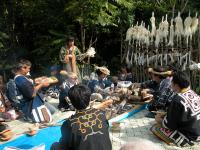A recent trip by IPinCH Project Director George Nicholas and Steering Committee member Joe Watkins reaffirms the relevance and importance of our IPinCH project. In early October, Joe and George were invited to speak on cultural and intellectual property issues, and IPinCH, at a workshop at Hokkaido University in Japan.
The event was organized by Dr. Hirofumi Kato, and sponsored by the university’s Center for Ainu and Indigenous Studies (CIAS). The purpose of the workshop was essentially two-fold. The first was for Joe and George to share some of their knowledge and experiences relating to intellectual property concerns in North America and elsewhere in the world, and to introduce the IPinCH project to the 30 or so Japanese scholars and Ainu representatives attending. The second was for George and Joe to learn about Ainu concerns relating to their cultural heritage, ranging from language preservation to cultural tourism to museums and education programs, as presented by Mr. Yupo Abe, Vice President of the Hokkaido Association, and others attending. The Ainu desire to share their culture with others, but also want to become aware of potential issues that other Indigenous groups have confronted.
The Ainu are the Indigenous people of Hokkaido and Sakhalin Island (now Russia). Subject to 150 years of Japanese rule, the colonial history of the Ainu is very similar to that of the Indigenous peoples of North America and Australia. Remarkably, however, they received official recognition as Japan’s Indigenous population only in 2008. The Japanese government is beginning to direct resources to develop Ainu-oriented education and research initiatives, such as CAIS, as well as to fund archaeological research and traditional use studies at Atsuma and other locations where future construction will impact Ainu cultural resources. There is thus much interest in learning from what has transpired elsewhere in the world with Indigenous peoples regarding the challenges of protecting cultural heritage, establishing research protocols, determining tribal membership criteria, among other needs—and, of course, their intellectual property.
What transpired at the Hokkaido University workshop, and in discussions George later had with Ainu representatives at the Ainu museums at Nibutani Dam, is that there is much interest in developing a collaborative relationship with IPinCH. With the support of the IPinCH Steering Committee in hand, Joe and George will be working with our colleagues at CAIS, Hokkaido University, and several Ainu communities in Hokkaido and Sakhalin Island in the near future to make this happen.
The Ainu are at a critical junction in their history as they begin to develop new relationships with both Japanese researchers and the Japanese state. Eventually, IPinCH will track, analyze, and theorize about these developments. Far more exciting, I think, is the opportunity we now have to work directly with the Ainu—and the other communities involved in IPinCH projects— to develop collaborative and community-based initiatives to aid their efforts for fair, equitable, and satisfying protection and promotion of their intellectual property.
The invitation to meet with the Ainu is but one of an increasing number of requests to IPinCH to provide information and advice on real-world situations that scholars and others are facing around the world. To provide but three examples: members of an American university sports team sought advice on use of a rock art image from an area whose original tribes are gone as a logo; an independent scholar who initially had the support of a Canadian First Nation to conduct research, but who now request that she draft a research protocol limiting her ability to publish her research results in order to limit other First Nations’ access to it due to competing land claims; and an archaeologist who is compiling a worldwide radiocarbon data base and has concerns over the inclusion of certain types of information. Such instances reveal the diversity of IP issues in cultural heritage emerging worldwide, which, in turn, provides IPinCH with valuable opportunities to know more fully the reasons for, and consequences of, their occurence.






